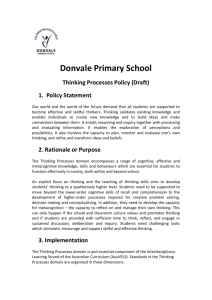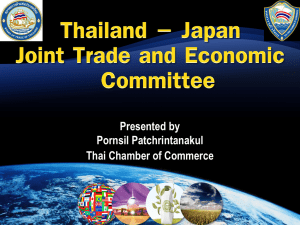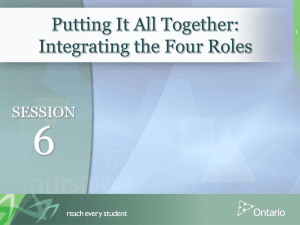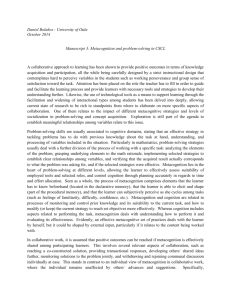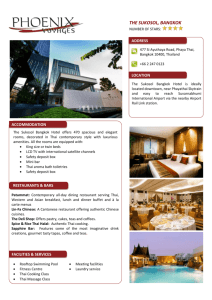1 The Development of Students` Metacognition on Indigenous
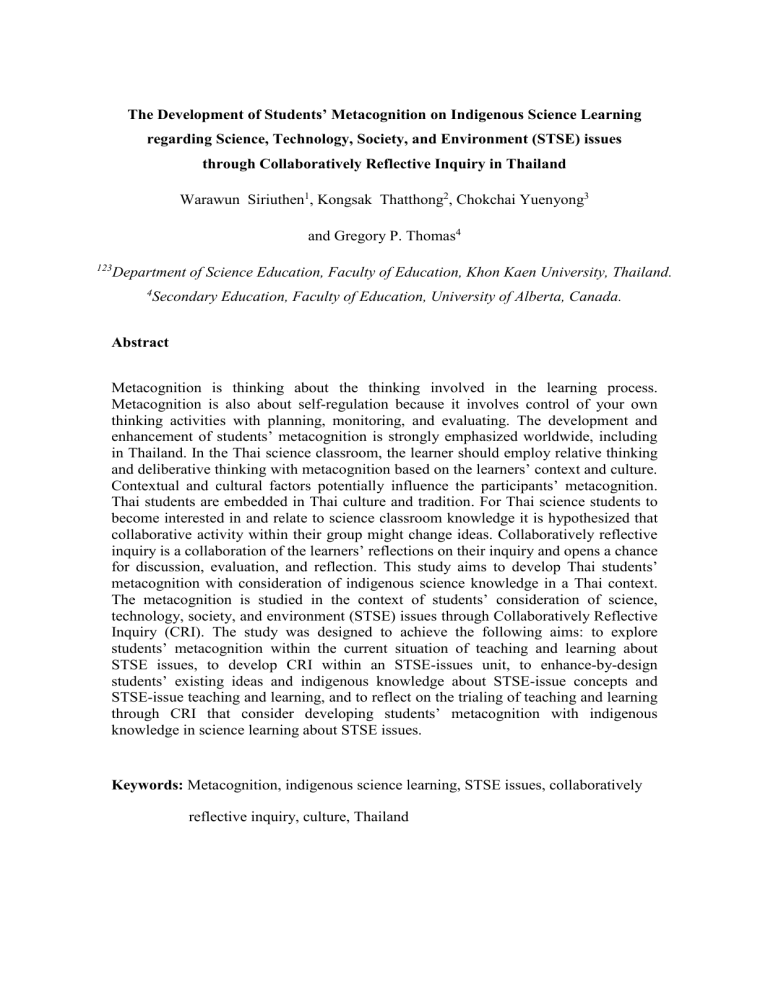
The Development of Students’ Metacognition on Indigenous Science Learning regarding Science, Technology, Society, and Environment (STSE) issues through Collaboratively Reflective Inquiry in Thailand
Warawun Siriuthen 1 , Kongsak Thatthong 2 , Chokchai Yuenyong 3 and Gregory P. Thomas 4
123
Department of Science Education, Faculty of Education, Khon Kaen University, Thailand.
4 Secondary Education, Faculty of Education, University of Alberta, Canada.
Abstract
Metacognition is thinking about the thinking involved in the learning process.
Metacognition is also about self-regulation because it involves control of your own thinking activities with planning, monitoring, and evaluating. The development and enhancement of students’ metacognition is strongly emphasized worldwide, including in Thailand. In the Thai science classroom, the learner should employ relative thinking and deliberative thinking with metacognition based on the learners’ context and culture.
Contextual and cultural factors potentially influence the participants’ metacognition.
Thai students are embedded in Thai culture and tradition. For Thai science students to become interested in and relate to science classroom knowledge it is hypothesized that collaborative activity within their group might change ideas. Collaboratively reflective inquiry is a collaboration of the learners’ reflections on their inquiry and opens a chance for discussion, evaluation, and reflection. This study aims to develop Thai students’ metacognition with consideration of indigenous science knowledge in a Thai context.
The metacognition is studied in the context of students’ consideration of science, technology, society, and environment (STSE) issues through Collaboratively Reflective
Inquiry (CRI). The study was designed to achieve the following aims: to explore students’ metacognition within the current situation of teaching and learning about
STSE issues, to develop CRI within an STSE-issues unit, to enhance-by-design students’ existing ideas and indigenous knowledge about STSE-issue concepts and
STSE-issue teaching and learning, and to reflect on the trialing of teaching and learning through CRI that consider developing students’ metacognition with indigenous knowledge in science learning about STSE issues.
Keywords: Metacognition, indigenous science learning, STSE issues, collaboratively reflective inquiry, culture, Thailand
2
Introduction and background
Over the past few years of educational reform movement in Thailand, attention to educational standards and quality has been intensified. The findings from the research on the educational reform movement have demonstrated that Thai youngsters at basic education levels had inadequate abilities to think analytically, and generally had low achievement in science. It was generally found that learners’ scholastic achievement, thinking and inquiry skills abilities were at an unsatisfactory level, although the students themselves, on their self-assessment, indicated a favorable level of achievement. Although the school teachers have attended in-service training courses and programs including further studies for higher degrees in their profession, there are still some lack in applying appropriate methods and strategies for the development of students’ learning achievement and their thinking abilities. Nonetheless, more than 90 percent of the schools under study were reaching an unsatisfactory level on both average achievement and thinking abilities.
Their analytical thinking is at the low level (Wiratchai, & et al., 2004). The students could not relate science knowledge in class to general life. These happenings might be attributed to the ineffectiveness of science teaching and learning. The researcher who has been a science teacher for 17 years disclosed that her students’ average scholastic achievement and thinking abilities needed to be improved. Concerned with these needs for the improvement in science learning and thinking skills, she proposed that metacognitive skills strategies should be incorporated in learning science.
On the learning process, the teacher has to understand that thinking is a process to be created--not only used to produce a content. Accordingly, teaching and learning have to be a similar process also. There is a need to use multiple learning theories. The cognitive learning theory explains a learning emphasize that changes the thinking process through cognition. For example, the reasoning and the focus is on what is happening in the learner. This process of cognition enhances the cognitive learner with the ability to interpret and organize information, and to use schema theory (Bruer, 1993, Mayer, 1996; Greeno, Collins, &
Resnick, 1996, cited in Eggen & Kauchak, 1997). Schema theory is the knowledge by the people that will be incorporating it into other units named “Schemata”. Schemata are knowledge units that have been complied by knowledge about persons, materials, places, events, processes, and perspectives. These arethe bases of learning (Rumelhart, 1984).
Intellectual growth occurs when learners are allowed to learn within the classification of their cognition group (Piaget, 1970). Most educators indicate that the most important thinking for cognitive learning is metacognition (Li & Munby, 1996).
3
The significance of Metacognition
Metacognition is a process with in-depth thinking by oneself in a situation and made effective from the thinking process by oneself (Flavell, 1976). It is defined as the ability of individuals to reflect, understand, and control their own thinking, learning, and acting. It is a cognitive process to control your own thinking activity with planning, monitoring, and evaluating.
Also, the development of the learner’s metacognition is a process of reflection on the thinking processes of analysis, synthesis, and problem solving, during teaching and learning activities
(Brown, 1987). These general issues of metacognition have been analyzed in detail and broken down into very specific components, such as declarative knowledge, procedural knowledge, planning, and monitoring (Sa´nchez-Alonso, S., & Vovides, Y. 2006 ).
Metacognition influences understanding with talking, writing, language ability, interest, recognition, problem solving, social recognition, monitoring, and several types of self management (Flavell, 1978). Metacognition is also involved with social learning theory, scalability of behavior recognition, personality development, and education. (Antonietti,
Ignazi & Prego, 2000, Glases, 1982, Davidson, 1994)
In Thai culture metacognition is portrayed in the Buddha doctrine of “Sati”. Sati is the feeling of your own. It is the control of mind and soul or mental coercion in their doing and thinking to know by being committed and impartial. Moreover, it is the review of thinking and behavior on your own about the accuracy, appropriateness, restraint-- a consideration in their mind how do they think and how they do. What is known is the carelessness, apathetic, and neutrality of the mind. If the person can control their Sati, they will be thinking what is indeed the cause of the system. Sati focuses on the “point of real” about three things called “Triluk”.
They are: “Anijang” where the body and mind is impermanent; “Thukkhang” where the body and mind is distress of ordinary people; and “Anatta” where the body, mind and everything is intangible and not under our power.
Metacognition is extremely important in learning because it is very important to solve problems in many areas; e.g., metacognition is important to reading development. (Hacker
1998, Jacobs & Paris, 1987); metacognition is important to personal mathematics
4 development (Schoenfeld, 1992); and metacognition is important to science knowing
(Georghiades, 2000, Rickey & Stacy, 2000, Shayer &Adey, 1988). So, the teaching of thinking processes and metacognition is important to people’s thinking. The thinking of people enhances the headway of a country (C, Charuenwongsak, 2003).
When the researcher surveys the students’ conceptualisation of metacognition in the science classroom learning environment by The Metacognitive Orientation Learning Environment
Scale – Science (Moles-s) and the Questionnaire of Metacognition on STSE (QM on STSE), there are very low dimensions of metacognition and STSE. There was no difference on sex, ages, classes, and schools. By the way, more than 90 percent of the schools under study were having unsatisfactory levels on both average achievement and thinking abilities (Wirutchai and associates, 2004).
From the above data, part would come from science classrooms without relevant thinking and deliberative thinking towards the learners’ context and culture. The learner cannot relate science knowledge to their life. The important things in the curriculum are not interesting for the learner. The development of students’ metacognition is urgently needed to be improved in science education in Thailand.
Accordingly, the development of students’ metacognition is the processes of reflection on learning, learning understanding, self- regulation, thinking processes, problem solving, and the use in students’ everyday life. So, the teaching and learning of science should focus on students’ metacognition on suitable science content. Which content is appropriate is STSE because teaching STSE concepts is relevant to the students’ everyday life or social situation.
Thailand STSE issues presented in the press, generally relate to environment, alternate energy, diseases, drugs and sports technology, materialism, elementary mechanics, women’s liberation, current electricity, mobile phones, nuclear power plants, and others.
When students are learning in science is should be to improve student thinking, but for that to occur there must be conflict in their thinking. They have to investigate the solution to questions through the process of problem solving. Students have to search for the information that is helpful to the problem solving. They need a decision to solve unclear problems. The activities are problem solving. The problem solving is a person’s individual practice for applying existing knowledge. People solve problems by their reasons and strategies with the
5 content, attitude, and their process skills. They keep investigating knowledge through inquiry.
The significance of science learning is improving students’ thinking and metacognition about their own learning by reflection on their inquiry----that is reflective inquiry. The reflective inquiry is the representation or evidence of learning, thinking, and understanding. It is related to an improved learning environment which is to enhance student learning processes and their learning orientation. If the teachers teach with metacognition and give students a chance with inquiry learning, then the learning can involve reflection and the learning can be authentic.
All of this will enhance the students’ problem solving that, in turn, can improve metacognition and self regulation because they need to control, monitor, and evaluate by their own thinking. Students will know the gaps in their learning and attempt to understand the needed knowledge (Schraw, 2006). The process of learning which gives a chance to the students to participate and cooperate with other students is collaboration. Collaboration can enhance the thinking of the teacher and the student for various reasons.
Collaboratively reflective inquiry is a collaboration of the learners. Small group work opens the chance for discussion, evaluation, and reflection (Davis, 2003). It enhances the metacognition and self regulation by encouraging their own planning and evaluating.
Accordingly, the development of students’ metacognition is a reflective learning process that promotes learning understanding and self-regulation by their own. That is the affect of a learning activity that emphasizes the thinking process and problem solving.
The teaching and learning in science for development of students’ metacognition on the topic of the STSE issues should support traditional knowledge or aboriginal knowledge on this situation with the collaboratively reflective inquiry.
The History, Cultural, Traditional, and Indigenous knowledge of Thailand
Thailand is in Southeast Asia country. There is a democracy system with his Majesty the
King. The country has a long history. There is evidence of ancient civilizations. Most residents are Buddhist. This is one of the important influences on culture. The cultural influence from Buddhism was inherited long ago. Thailand never was a colony of a western country, therefore, Thai residents have only small effects from western culture. The culture is a merge of India and China; e.g., for 2,000 years the existing Thai rice is sticky rice and was eaten by hand. When India affected change in Thai, the rice now in use is a different species; we also use folk and spoon now, and we eat soup from the Chinese culture. The draping has
6 also changed. Thais wore no shirt for a long time but western culture has affected a Thai change to shirts. About learning: traditionally Thai men learned with the monk in the temple and Thai woman did not have the privilege of learning. A monk taught Buddhist principles in the temple. So, Thai culture has several important days in Buddhism and in the temple.
The Buddhism principle and preaching are concordant in Buddhist life and in the Thai people.
The Buddha uses several teaching techniques with Buddhist emphasis and collaboration as follows: 1. Described technique is the teaching in content of the principle of Buddhism by one-to-one, small group, and large group. 2 . Metaphorical technique or “Auphama technique” is the most used teaching technique, where easy-to-understand examples in their life to are employed. 3. Ask and question technique or “Sa-Kad-Sha” or “Phud-Sha-Visad-
Chana” is the teaching when you talk with the disciple and are walking outside. For example,
Buddha asked: how many types of the person intelligence are displayed when you see the lotus? The disciple talked with many answers. Buddha described: the person’s intelligence is the same as the lotus. Some intelligent person is the same as an above-water lotus; some medium intelligent person is the same as a surface-water lotus; some a–bit-intelligent person is the same as in-the-water lotus, and some not intelligent person is the same as mire (waterbottom) lotus. 4. Yo-Ni-So-Ma-Na-Si-Kan technique is the teaching of thinking, systematic thinking, and analytically thinking that consists of problem consideration called “Manasikan”, of how the problem is related to others called “Patamanasikan”, of the search of the cause of the problem called “Kanranamanasikan”, and of thinking to solve the problem with discovery inquiry, and of identifying problems called “Aupphatagamanasikan”. 5. Analysis technique or “Viphashawad” is the teaching to separate and distinguish knowledge for good understand.
6. Demonstration technique is the teaching to show the goodness of a person (Kurdkaew, T.,
2002). Moreover, another principle of Buddhism that is important to Thai life is
“Kalamasud” that influences ones way of life, behavior, and belief. Everyone can construct knowledge on their own when they seek with their eyes and their mind.
Accordingly, the monk and the temple has an important role to all ages and sex in Thai life.
The Thai temple is included in culture and tradition. Thai people bring the Buddist principle and doctrine to their life. Many temples in Thailand write the doctrine and tradition on the wall for memory such as: Wat Pho in Bangkok drawing Thai massage, Wat Kong Ka Ram in
Rachabury drawing the Buddha's biography, Wat Pra Sing in Chaingmai drawing Lannas’ life in the North, Wat Pu Min in Nan drawing Northern residents’ history and beliefs, and
7
Wat Nong Wang in Khon Kaen drawing “Kalum” that is a prohibited practice of Thai in
Northeast of Thailand.
The Northeast of Thailand is the land closest to Laos and Cambodia. There is wide land in 19 provinces that has plateaus, insufficient rain, and hot weather. They have a special culture, language and traditional. They have been influenced by Larn Chang and call “E-San”, that is, to respect your ancestors, parents, ancestor’s spirit, home spirit, and farm spirit. Most of the
E-San Thai farm. So, their life binds with Buddhism tradition and the farming tradition. The
E-San characteristics include eating, song, learning, dancing, and language, dependence on
Buddhism, farming, landscape, climate, and regime. For example, “Heat-Sip Song” are 12 traditions of 12 months in the year that E-San Thai should do and “Kong- Sip Si” are 14 rules for the parents. The Bung Fi Festival involves the Heat-Sip Song in the rainy season because the farmers need the rain from the heaven for their farm, and the Su Khuan Ceremony is the psychology of E-San Thai for encouragement to be patient, to go far, to greet guests, to enhance the sacred, and to be lucky.
Furthermore, the E-San has much local wisdom for a long time within their life. These are as follows:
The wicker is the material used to produce many things by the E-San farmers. The many kinds of wicker produced from bamboo suit different activities and uses, such as Kra
Tip Khao for sticky rice, Kra Bung for holding many things together on the farm, Kra Om for water, and Ngob for sunlight protection.
Khao Hang is the good quality, famous rice that is produced by E-San local wisdom tradition. The farmers discovered that when they soak the rice in water it stimulates the growth of rice. After that, they dry it out with sunlight and shell-it-out. This product has much nutrients, vitamins, fiber, and a good smell. This also makes one healthy and balanced, and protects one from many diseases such as high blood pressure, diabetes, high fat, heart disease, rheumatoid arthritis, Alzheimers, and beriberi.
Sa Mun Prai is the herbal medicine from local plants. They are in Thai society and used by Thai people for a long time. They have the property for treatment and care of health, such as, Roselle and Passion for blood pressure, White Crane flower and Periwinkle for cancer, and Ylang-ylang Tree and Rose for heart.
Thai silk is the cloth made from silk. It is a product from Mulberry leaf using complicate processes including coloration and weaving techniques. The Thai silk is delicate
and beautiful. Thai tradition requires that Thai woman (to be a good woman in the family) have to weave cloths and show them at ceremonies.
Thai massage is used for health care and therapy. Massage causes blood flow, muscle relaxation, better joints, stimulation of the nervous system, and a refreshing nature.
8
Furthermore, E-San have the Guru to consider exemplary human resources and local knowledge. They live life in the sufficiency economy philosophy of His Majesty King
Bhumibol Adulyadej for the benefit and happiness of the Thai people. They are Mahayu
Sunthonchai in Surin Province, Chalee Marasang in Ubonrachatanee, Thongdee Nantha in
Khon Kaen Province, and Kumduang Pasee in Bureerum Province.
“
Sufficiency Economy
” is a philosophy bestowed by His Majesty the King to his subjects through royal pronouncements made on many occasions over the past three decades. The philosophy provides guidance on appropriate conduct covering numerous aspects of life.
After the economic crisis in 1997, His Majesty reiterated and expanded on the concept of
“Sufficiency Economy” in further remarks made in December 1997 and again in December
1998. The philosophy points the way to recovery that will lead to a more resilient and sustainable economy—a better way to meet the challenges arising from globalization and other changes.
“Sufficiency Economy” is a philosophy that stresses the middle path as an overriding principle for appropriate conduct by the population at all levels. This applies to conduct at the level of the family and the community, as well as at the level of the nation, in terms of development and administration in order to modernize in line with the forces of globalization.
“ Sufficiency ” means moderation, reasonableness, and the need for self-immunity to gain sufficient protection from impacts arising from internal and external changes. To achieve this, the application of relevant knowledge with due consideration and prudence is essential. In particular, great care is needed in the utilization of theories and methodologies at every step of planning and implementation. At the same time, it is essential to strengthen the moral fiber of the nation, so that everyone, particularly public officials, academics, and business people at all levels, adheres first and foremost to the principle of honesty and integrity. In addition, a way of life based on patience, perseverance, diligence, wisdom and prudence is indispensable to create balance and to enable people to cope appropriately with critical challenges arising
9 from extensive and rapid economic, social, environmental, and cultural changes in the world.
(Wibulswasdi, Piboolsravut, & Pootrakoo, 2010).
Cultural studies of science education in Thailand may reflect Eastern cultural ways of knowing , that is, indigenous ways of knowing before colonization. The students must reject their Western cultural ways of knowing to participate in the classroom’s community of science learners. This is also the case to some extent for Asian students (Aikenhead, 2005;
Cobern, 1996a; Kawasaki, 1996, 2002; Lee, 1997; Ogawa, 1995; Tsai, 2001b).
The STSE situation in Thailand Science Curriculum
The Ministry of Education announced implementation of the Basic Education Curriculum
2001, which served as the core curriculum for national education at the basic level. The curriculum prescribed goals and learning standards. It also provided a framework and orientation for enhancing quality of life of learners, who would attain virtue, wisdom, as well as capacity to maintain Thailand’s competitive position in the world community. On the capacity for applying life skills for applying various processes in daily life; self-learning; continuous learning; working; and social harmony through strengthening of happy interpersonal relationships; elimination of problems and conflicts through proper means; ability for self-adjustment to keep pace with social and environmental changes; and capacity for avoiding undesirable behaviour with adverse effects on oneself and others. And goals of education to awareness of the need to preserve all aspects of Thai culture and Thai wisdom, protection and conservation of the environment, and public-mindedness with dedication to public service for peaceful and harmonious co-existence (Ministry of Education, 2001).
On the Learners’ quality and Learners’ Competencies of science curriculum defined in the need to work constructively with others, to express opinions based on reliable references and sound reasoning resulting from scientific and technological development and application, tp bear in mind ones moral obligation to society and the environment, and to be ready to acknowledge views of others (Ministry of Education, 2008).
The translation of the science curriculum to the classroom has not been obvious, and especially of the teaching and learning of STSE issues. In class, teachers teach on eight standards that are without STSE issues. On Standard 2, Life and the Environment, there is an ecology content in the textbook with a bit that points to social, culture, and STSE issues.
10
This Research
This research could be carried out with Grade 10 students to teach STSE issues generally related to environment, alternative energy (e.g., nuclear power plant), diseases, sports technology, materialism, technology careers and woman’s liberation, mobile phone, and others. For example: the effect of the earthquake, tsunami, nuclear power plant, and radiation in Japan on March 11, 2011. In Thailand, on December 26, 2003 the effect of the tsunami from Sumastra Island of Indonesia damaged Southeast of Thailand and much of western tourism passed away, but the Morgan as an aboriginal people survived. This is STSE issues in science learning and is interesting. In Thailand this is called “U Ka Fa Luang”-- that will be the natural unfortunate effect when the yellow sky happens and the sea tide ebbs. It is the traditional knowledge.
Accordingly, this research is aimed to develop Thai student metacognition. It is the consideration of the indigenous science knowledge in a Thai context on social issues on science, technology, society, and environment (STSE) \through Collaboratively Reflective
Inquiry (CRI).
Research Questions
There are three research questions as follows:
1. What is the current situation of teaching and learning about metacognition and STSE issues in Thailand?
2. How do Thai students employ metacognition on indigenous science learning regarding
STSE issues?)
3. Does, and if so how does, collaboratively reflective inquiry enhance students’
metacognition on indigenous science learning regarding STSE issues?
Aims of the Research Study
The purpose of the research study is to enhance students’ metacognition in indigenous science learning on the topic of STSE issues through collaboratively reflective inquiry (CRI) in
Thailand. The study is designed to achieve the following aims:
• To explore students’ metacognition and the current situation of teaching and learning about STSE issues;
• To develop the CRI on indigenous science learning regarding STSE issues unit and
11 design; and
• To reflect on the trialing the STSE issues teaching and learning through CRI that consider the development of students’ metacognition on indigenous science knowledge in science learning about STSE issues.
Operational Definition of Terms
Four important terms introduced in this study are operationally defined as follows.
Metacognition is a process with in-depth thinking of oneself in a situation and effected by the thinking process of oneself (Flavell, 1976). It is defined as the ability of individuals to reflect, understand, and control their own thinking, learning, and acting. It is the cognitive process of controlling their own thinking activity with planning, monitoring, and evaluating
(Brown, 1987).
Metacognition refers to an individual’s knowledge, awareness, and control of his/her thinking and learning strategies (Thomas, 2009). Metacognition consists of three strategies during their science learning: metacognitive knowledge, metacognitive control, and metacognitive awareness (Thomas, 2003).
Collaboratively reflective inquiry (CRI) is a reflection on scientific inquiry. It relates to students’ interpretation on their own. Collaborative concept design refers to intensive collaboration among designers, who strive for and create a shared understanding of the product concept (Volpentesta and Muzzupappa, 2006). Collaboratively reflective inquiry is a relationship between the reflection, the thinking and the learning collaboration. This is most important to improving student knowledge. Reflective inquiry, then, is made necessary, since knowledge is “not a fixed possession” … “Learning by Doing” (Dewey, 1938). Student collaboration usually involves tutors or small collaborative work groups. Research suggests that peer tutors, who are judged to be of similar ability to their tutees, increase the declarative and procedural knowledge and self-efficacy of those students (Pajares, 1996).
Collaboration also encourages students to engage in spontaneous reflection when they compare their work with that of others or are exposed to multiple perspectives in the classroom (Lin, 2001).
Indigenous science knowledge is the science knowledge in the social and cultural context. It is the aboriginal knowledge. The student learns science up close and personal in students’ everyday lives: health systems, political system, the media, environmental groups, and industry (Weinstein, 1998). Cultural studies in science education must reject Western cultural ways of knowing to participate in the classroom’s community of science learners. This
12 research is the Thai local wisdom about people and knowledge in Northeast of Thailand such as: the wicker, Khao Hang, Sa Mun Prai, Thai silk, Thai principle, Thai tradition, and Thai massage.
STSE issues are relevant to the students’ everyday life or social situation. Thailand STSE issues presented in the press generally relate to environment, alternative energy (e.g., nuclear power plant), diseases, dug and sports technology, materialism, elementary technology career and woman’s liberation, mobile phone, and others.
Anticipated Outcomes
When finishing the study, the researcher expects the following outcomes:
- the guiding principles underpinning the administration and the design of science learning is to define science curriculum as thinking development;
- the guiding underpinning for teaching the general science teacher is developing metacognition throughSTSE issues, concept strategies, learning activities, teaching materials, and assessment techniques.
- the learner practices are planning, controlling, monitoring, and evaluating by their own and by adapting to their life.
Delimitation of the Study
This study is dividing into two main phases. The first phase is to explore the state of students’ metacognition and of the current situation of teaching and learning in the
Northeast of Thailand and Khon Kaen Province in the first semester of the 2011 academic year at grades 10,11 in high school. , This first phase aims to know students’ metacognition and current situation before any intervention. The follow-up second phase is to be conducted in the second semester of the 2011academic year in four classrooms in grade 10 high school in Khon Kaen Province with the collaboratively reflective inquiry for developing students’ metacognition.
13
Summary
Metacognition is a thinking process necessary for promoting scientifically literate individuals. It is strongly emphasized in science education worldwide, including Thailand.
Metacognition is a kind of higher order thinking that enriches individual thinking.
Metacognition involves the learning process and self-regulation, requiring studentsto control their own thinking activity with planning, monitoring, and evaluating. In Thai science classrooms there should be an opportunity to let the learner employ deliberative thinking with metacognition, based on the learners’ context and culture. Thai students are embedded in Thai culture and tradition. For science student learning to be interesting and to relate science knowledge to their life indigenous science knowledge should be employed in the science classroom.
Students’ understand of their science learning should be enhanced with talking, writing, language ability, interesting content and processes, recognition of learning, problem solving, social recognition, monitoring, and self management. Accordingly, the development of student metacognition should be used during inquiry learning to help them to reflect on their thinking and on how they know. Collaboratively reflective inquiry (CRI) regarding collaborative activity with their group should be used to show how students might come to change ideas. This collaboratively reflective inquiry is a collaboration of the learners. The small group work opens a chance for discussion, evaluation, and reflection. It enhanced the metacognition by their planning and evaluating.
Bibliography:
Aikenhead, G. S. (2005). Culture Studies: School Science as Culture Transmission.
Science Education for Everyday life , 107-127.
Anderson, C.W. (2007). Perspective on Science Learning. In S.K. Abell and N.G.
Lederman. (Eds.), Handbook of Research on Science Education (pp. 3-30). New
Jersey : Lawrence Erlbaum Associates, Inc.
Flavell, J. H. (1979). Metacognition and cognitive monitoring: A new area of
Cognitive developmental inquiry. American Psychologist , 34, 906–911.
14
Ministry of Education. (2008). National Basic Education Curriculum . Bangkok. Thailand.
Schraw, G.,Crippen, K. J. & Hartley, K. (2006). Promoting Self-Regulation in Science
Education: Metacognition as Part of a Broader Perspective on Learning. Research in
Science Education , 36(1), 111-139.
Thomas, G. P. (2002). The social mediation of metacognition. In D. McInerny & S. Van
Etten (Eds.), Research on sociocultural influences on motivation and learning (Vol. 2, pp. 225–247). Greenwich, CT: Information Age Publishing.
Weinstein, M., (1998). Playing the paramecium: Science education from the stance of the cultural studies of science. Educational Policy , 12, 484-506.
Wiratchai, N., & et al. (2004). The development school system . Chulalongorn University :
Bangkok.
…………………..
